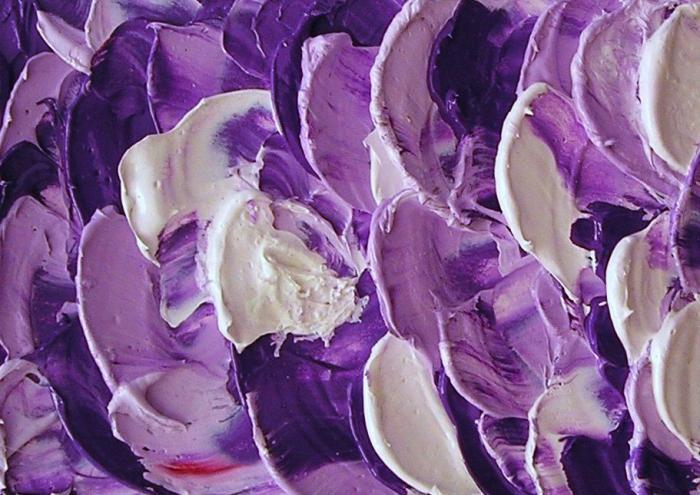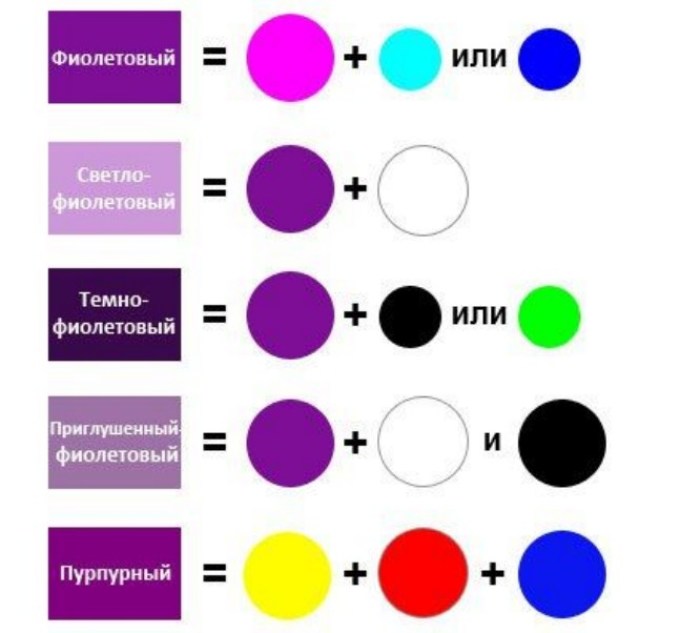In this article, we offer ideas and advise which it is better to mix colors in order to get one or another shade of purple color.
Content
- What colors of colors need to be mixed to get a purple color of gouache, paints: step -by -step instructions
- How to make light purple, pale purple of colors, gouache when mixed?
- How to get a dark purple color when mixing paints, gouache?
- How to get lilac when mixing paints, gouache?
- How to get lilac when mixing paints, gouache?
- Shades of purple: palette, colors of flowers
- Flower mixing table
- Video: Mix paint and get purple color
To obtain a harmonious and complete drawing or picture, artists use many colors and shades, which are often obtained after connecting a certain number of colors. This also applies to the purple tint, it is quite possible to do it independently, mixing in equal quantities, red and blue. We will consider in more detail the options for mixing in the article.
What colors of colors need to be mixed to get a purple color of gouache, paints: step -by -step instructions
There are three main options for the color scheme, when mixing which you can get one or another shade that you need:
- Yellow
- Blue
- Red

Accordingly, to lighten color, you need to use white paint. Well, for dimming - it should be added to a mixture of the basic colors, black or dark paint, depending on what color you need.
- The main thing is to use pure paints to obtain the desired color, without different contaminants. This is especially true for light shades, which are quite difficult to fix if the color is not quite the same.
- To obtain saturated purple ring, it is better to use bright red color, and better bright ultramarin, without green or yellow shades, because As a result, a brown color can be obtained.
- Checking extra shades or pigments is very simple, for this you need to add a few drops of whitewashing to the paint.
- You can mix the shade both on canvas and on the palette, the main thing is to use the palette of only white colors or the color of the main background, because On wooden or dark palettes, the resulting color can be distorted.
- For mixing gouache, it is best to use a ceramic or disposable plate. It is better to change the water that you use as often as possible, so that the shades are clean, and the pictures are clear.
In order to highlight certain parts, using the minimum amount of water when mixed. Before applying Guasha to the drawing, it is better to draw a sketch with a simple pencil, and in the process to wash it with an eraser.
How to make light purple, pale purple of colors, gouache when mixed?
Many artists are quite familiar with the situation when the necessary color or shade has ended. It is easy to solve such a problem, and you should not immediately go to the store for a new tube, it is worth mixing several colors, mainly 2-3 and you can get the color you need. It is worth, of course, to take into account the presence of those tints, due to which the missing paint is possible. And to be sure of this, just look into the flower mixing table.
Since school times, everyone knows that purple is a secondary color that can only be obtained due to a mixture of red and blue, but difficulties arise if a different shade of this color is needed, for example, pale purple, or light purple. In such a situation, not everyone, even professionals, manages to bring the desired shade to the ideal. Therefore, it is best to gradually introduce additional to the main color, and it is advisable to do this not immediately on canvas, especially if you use gouache.

To obtain such shades, you need to mix the pink color of the paint or gouache with blue. If there are no such marching colors, then you need to add white color to a mixture of red and blue colors. It is better to do this on the palette to reliably make sure that this is exactly the color that you need. For such manipulations, it is best to use red kolbat or ultramarin, and the shades of the azure or fluceanin are more suitable from the blue palette.
If you add cold red to black, you can result in a muffled purple hue. For such manipulations, it is better to use the shades of red as alizarin or flutocyanin. And to lighten, use clean white paint or special white.
Of course, purple, as well as its shades, are quite beautiful and used not only in art, but also for painting walls, creating a new interior design, even for hair coloring. Colors have an important role, and are used in many areas of activity, it is worth knowing how to get this or that shade correctly.
How to get a dark purple color when mixing paints, gouache?
As a result of the connection of red and blue in a variety of proportions, you can get a whole range of purple shades. In order for your new kner to be accurate and corresponded to the plan, it is necessary to thoroughly mix the colors with each other, because as a result of improper mixing on the canvas, unwanted stripes or stains may form during the process. For such manipulations, artists most often use mastichin - this is a special thin spatula for mixing colors.
- Of course, the purple color, as described above, can be obtained by mixing red and blue, but if it is incorrectly selected shades of these colors, you can get an incredible result, for example, with a gray or brown tint.
- When connecting cold shades of red and blue, you can definitely get a rich color, from which a dark shade of purple will be perfectly obtained. Of course, to get the desired, you need to add a black or dark gray color, this is at your discretion, because There are many dark shades of purple.

- It is desirable, when adding black, use a deep, saturated kner, according to the type of black resin. The amount of black color depends on the desired result that you need, it is best to add it gradually, while thoroughly mix the colors, because the black color often absorbs red and its marching, so it will not turn out purple with a red or fiery tint.
- To obtain a bright purple color, experienced artists often use a combination of blue or tangent color with mandenta. This combination of 100% will give the necessary result, while from the resulting color, you can easily make various shades, both light and dark.
- The color of the mandena can be compared with ink from the printer, and in order not to be mistaken when buying, you just need to print an example and compare the desired shade in comparison.
It is worth remembering that dark shades absorb red, and therefore often turns out to be a “eggplant” shade of purple when mixing with black. This should be taken into account if you need purple or red-violet color. A similar shade can only be obtained by mixing a dark purple color with a small amount of pure white, while a grayish tint can also be observed.
How to get lilac when mixing paints, gouache?
It seems simple to achieve the desired effect in the process of connecting paints only at first glance, including this applies to purple shades. Most colors can “absorb” others, while dominated by the resulting shade, therefore, it is worth gradually introducing new colors, and mix very well, as described above. Professionals perform this work directly on the catfish catfish, but if you doubt it, it is better to do this on a ceramic plate or a special palette.
- Despite the fact that violet color is not considered basic, it has a lot of flooding colors, and as a result of the introduction of additional colors to the basic colors or, directly to the purple, you can get almost 200 of various hiking shades of this color, starting from white-lilac, Finishing to a dense purple. To guess the correct proportions of the desired kings and is the main problem, because The transition from one shade to another has a very thin line.

- Traditionally, a lilac shade, as well as the main purple, are considered cold colors, and, of course, the initial stage of manufacture is the mixing of blue and red tints.
- It is easier to get a lilac color for this, for this, to the “ordinary” purple color, which is made from cold blue and cold red, add whitewash.
- Lilac color is attributed to the third group, because You can get it when connecting 2, or even 3 or more kings.
If, as a result of manipulations with tones, you have a lilac color that shakes the red or pink tint, while you need a cold shade of lilac, it is easy to fix this problem, just add a small amount of black color to the mixture that, after mixing, absorb the redness.
How to get lilac when mixing paints, gouache?
Of course, the lilac shade is very beautiful, and the colors of similar colors are often taken for wall design in the interior of the house. But, of course, in nature you can find a large number of plants that have a purple color. Among them, a huge amount is occupied by vegetables, berries, flowers. But this color does not apply to the primary, original colors.
- Lilac, as well as lilac and other hiking from purple, are considered a secondary color, because It turns out as a result of the connection of other colors.
- If you use gouache, then it is worth stopping your attention on what name the purple color carries. There are 2 categories of this color - this is K and C. In the first case, the red shade is dominant, and in the color scheme, to be between the red and purple color. But in the second case, the purple has mainly blue kner, and is between blue and purple in the color scheme.

- Of course, there are also a large number of shades of lilac, and therefore, Belila must be added carefully. The classic “recipe” of a lilac shade is considered to be a connection in equal proportions of red, blue and white.
- You can go the other way, in the presence of pink and blue, they must also be thoroughly mixed and thus the desired purple color will turn out. If you do not have such shades, then you can separately bleach the red color until the pink, and blue - to receive blue.
If you use watercolors, then in this case the white one will not be needed, and ordinary water plays the role of the clarifier, the main thing is to change it more often for the cleanliness and clarity of the pattern.
Shades of purple: palette, colors of flowers
Violet, today, is very popular among interior and clothing designers. Also, it is difficult to imagine various paintings without using at least one shade of such a tint. As you know, purple is mined by combining beauty and blue, for lightening it will need to be white, and a black or simply dark color will help to saturate paints with a darker tint.
In the palette panton, almost 200 shades of this color are charged, in which you can find not only bright, bright, dull shades, but also dark, deep, with a blue or pink tint.
The most popular colors of purple gamut are:
- Deep, dark and rich:
- Plum
- Silk
- Eggplant
This group presents those collars who do not have redness, and blue or gray are dominant.
- Light:
- Lilac
- Fial
- The color of the orchid
- Amethyst
- Pearl
- Fuchsia (has a brighter color)

These shades echo with delicate scarlet tones, have red half -ton, precisely due to this characteristic, these collars belong to warm shades.
- Cold shades:
- Dark purple
- Indigo
- Saturated, dark silky
- Violet electric
- The color of black currant
Here are those colliers that mainly have a deep blue half -ton. Classic purple is considered the sixth main color, it has a huge number of shades, while having various castings, the main of them, as mentioned above, is red and blue, there are also gray, pink, blue and even orange.
Flower mixing table
Today, the use of non -standard colors is considered fashionable not only in clothes, but also to create modern paintings and drawings. Using various shades, you can convey the depth and accuracy of the image, and most often the desired result can be obtained only by mixing other colors.
There are chromatic shades that are placed nearby in a circle of color combinations, as well as ahromatic - located far from each other or opposite, when they are mixed, a shade with a predominance of gray tide is obtained. Of course, to obtain the expected result, you need to understand the color scheme, and the correct proportion when mixing, but it is also important to use materials that have a similar chemical composition. This can radically change the result, or it will turn out completely not the color that you need.
In order for the result to be as accurate as possible to mix a small number of colors, because With large volumes, you can not guess with accuracy in proportions. The table that we offer can greatly simplify the task in search of the desired shade, is used in various areas of life.

Thanks to knowledge of the correct mixing of colors, you can create real masterpieces. Good luck in creativity.








What a rich color, how many colors should be mixed. Class!